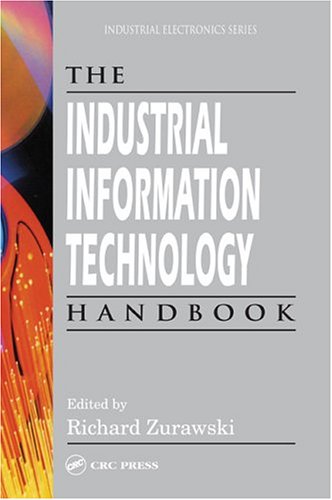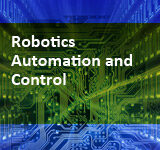| Book Name: | The Industrial Information Technology Handbook |
| Category: | Mechatronic Book |
| Language: | English |
| Format: | |
| Free Download: | Available |
Free PDF Download The Industrial Information Technology Handbook

Book Description:
The Industrial Information Technology Handbook by Richard Zurawski (CRC Press) focuses on existing and emerging industrial applications of IT, and on evolving trends that are driven by the needs of companies and by industry-led consortia and organizations. Emphasizing fast-growing areas that have major impacts on industrial automation and enterprise integration, the Handbook covers topics such as industrial communication technology, sensors, and embedded systems.
The Handbook presents tutorials, surveys, and technology overviews, combining fundamentals and advanced issues, with articles grouped into sections for a cohesive and comprehensive presentation. The text contains 112 contributed reports by industry experts from the government, companies at the forefront of development, and some of the most renowned academic and research institutions worldwide. Several of the reports on recent developments, actual deployments, and trends cover subject matter presented to the public for the first time.
Features:
* Introduces software and web fundamentals such as development platforms and frameworks, middleware, .NET, Java, and multidimensional database technology Discusses Internet and IP-related issues including core protocols, QoS in IP networks, network security, and ad hoc networking
* Analyzes industrial communication systems, focusing on field area networks, Ethernet, mobile networks, security, and more
* Overviews Internet, web and IT technologies in industrial automation and design.
* Explores real-time embedded systems and networked embedded systems
* Describes integration issues including e-Manufacturing, XML applications, network-based integration technologies, agent-based technologies, and applications for energy and power systems
Excerpt:
The purpose of The Industrial Information Technology Handbook is to provide a reference useful for a broad range of professionals and researchers from industry and academia involved or interested in the use of information technology (IT) in industrial applications ranging from industrial automation to industrial enterprise integration. This is the first publication to cover this field cohesively and comprehensively. The focus of this book is on existing technologies used by the industry and newly emerging technologies and trends, evolution of which has been driven by the actual needs and by the industry-led consortia and organizations.
Over the last decade, IT has profoundly impacted the evolution of industrial enterprises into fully integrated entities. Nowadays, we witness major efforts led by some of the largest multinationals to harness IT to achieve integration of I/O control, device configuration, and data collection across multiple networks and plant units; seamless integration between automation and logistic business levels to exchange jobs and production data; transparent data interfaces for all stages of the plant life cycle; the Internet- and Web-enabled remote diagnostics and maintenance, as well as electronic orders and trans-actions. Some of the IT technologies used in the office and enterprise operation have been adopted and/or transformed to suit and advance industrial controls and automation, and industrial enterprise integration. OPC, Real-Time Corba, Real-Time Linux, Windows CE, real-time specifications for Java (RTSJ, RTCE), and Real-Time UML are good examples, to mention some. The Internet technologies extended the boundaries of the operation of industrial enterprises to their customers and suppliers, as well as the management and technical staff through electronic commerce, B2B, remote data access, and monitoring and control. The industrial IT field spans a number of technological areas such as software and hardware technologies, as well as Web and networking technologies. Those technologies, when used in an integrative way, offer a potential for horizontal and vertical integration of functional layers of industrial units and enterprises, thus transforming traditional islands of automation and enterprise operations into more integrated enterprises better adjusted to cope with the demands of competitive markets.
The book contains 112 contributions on topics related to industrial IT, written by experts from industry and academia. One third of the contributions are from industry and industrial research establishments, from the leading multinational corporations at the forefront of the development of IT and industrial automation technologies, to mention ABB (Germany, Norway, Sweden, and Switzerland), Alcatel (Belgium), Cadence Systems, Microsoft Corporation, NEC Labs (U.S.), Rockwell Automation, Schneider Electric (France and Germany), Siemens (Austria and Germany), Volvo Truck Corp. (Sweden), and Yokogawa America. Most of the multinationals mentioned play a leading role in the formulation of long-term policies for technology development, and are key members of the industry-academe consortia implementing those policies.
The contributions from academia and governmental research organizations are represented by some of the most renowned and reputable institutions such as Columbia University, Cornell University, Frauenhofer FOKUS (Germany), Georgia Institute of Technology, Monash University (Australia), National Institute of Standards and Technology (U.S.), Princeton University, Politecnico di Torino (Italy), UC Berkeley, UC Irvine, UC San Diego, University of Texas at Austin and Dallas, University of Tokyo, Stanford University, Technical University of Berlin, Vienna University of Technology, and many others.
The material is presented in the form of tutorials, surveys, and technology overviews combining fundamentals with advanced issues, making this publication relevant to the beginner as well as seasoned professional from industry and academia. Particular emphasis is on the industrial perspective, illustrated by actual implementations and technology deployments. The contributions are grouped into sections for cohesive and comprehensive presentation of the areas treated. Some of these sections can be used as a reference material for study (including a formal coursework) at the intermediate through advanced levels. The reports on recent technology developments, deployments, and trends frequently cover material released to the profession for the first time.
The handbook is designed to cover a very wide range of topics that comprise the field of industrial IT. The material covered in this volume will be of interest to a wide spectrum of professionals and researchers from industry and academia, as well as graduate students, from the fields of industrial and mechatronic engineering, production engineering, electrical and computer engineering, computer science, and IT.
The book is organized into two parts. Part 1, Fundamentals of Information Technology, presents material to cover new and fast evolving aspects of IT. Part 2, Industrial Information Technology, introduces cutting-edge and emerging industrial IT areas.
The focus of the book is on fast evolving areas with a major impact on the evolution of industrial automation and industrial enterprise integration. Some of those areas have received limited coverage in other publications due to the fast evolution of the technologies involved, or material confidentiality, or limited circulation in the case of industry-driven developments. The book covers industrial communication technology, sensor technology, embedded systems, the Internet, Web and IT technologies in industrial automation, and industrial enterprise integration. To complement this material, it felt appropriate to include background reading material on some of the fastest-evolving IT and IP networking areas. This has been done primarily to assist readers with little or no background in IT and networking technologies, both essential to understanding most of the chapters in Part 2 of the book.
Part 1 has two sections: Computer Software and Web Technologies and The Internet and IP Networks. The section on Computer Software and Web Technologies introduces some of the recent software technologies, platforms, and solutions that have had a profound impact on industrial control and automation, and industrial enterprise integration. It covers material in subsections: Development Platforms and Frameworks, The Unified Modeling Language, Middleware, Web Technologies, Web Programming, and Multidimensional Databases. Specifically, this section introduces J2EE platform and .Net framework in the Development Platforms and Frameworks subsection. J2EE is used extensively at the enterprise business level. The .Net is studied and experimented with by the industry for applications ranging from control to enterprise integration. The subsection The Unified Modeling Language provides an overview of UML and its extensions, variants, and implementations. The UML language has become a de facto standard for modeling real-time and embedded systems, industrial control and automation, as well as business systems. The contribution on UML also introduces selected applications of the language in control and automation. The Middleware subsection on network connectivity software gives a roundup of Microsoft’s distributed components technologies and Object Management Group Corba standard for object-oriented distributed computing, both of central importance to industrial control and automation. The Web servers, clients, browsers, and languages used for Web and Internet programming are introduced in the Web Technologies subsection. The client-server model is dominant in legacy automation systems. Web services, which allow for platform and language independence in the client-server model, are discussed in the Web Programming subsection. The Multidimensional Databases subsection gives an overview of m.
The Industrial Information Technology Handbook (Industrial Electronics) PDF
Author(s): Richard Zurawski
Series: Industrial Electronics
Publisher: CRC Press, Year: 2004
ISBN: 9780849319853,0849319854









![[PDF] Draw Buildings and Cities in 15 Minutes Draw Buildings and Cities in 15 Minutes pdf](https://www.freepdfbook.com/wp-content/uploads/2021/06/Draw-Buildings-and-Cities-in-15-Minutes-218x150.jpg)








![[PDF] Digital Image Processing An Algorithmic Introduction Using Java Digital Image Processing An Algorithmic Introduction Using Java](https://www.freepdfbook.com/wp-content/uploads/2022/06/Digital-Image-Processing-An-Algorithmic-Introduction-Using-Java.jpg)




![[PDF] 43 Years JEE ADVANCED + JEE MAIN Chapterwise & Topicwise Solved Papers 43 Years JEE ADVANCED (1978-2020) + JEE MAIN Chapterwise & Topicwise Solved Papers Physics PDF](https://www.freepdfbook.com/wp-content/uploads/2022/03/43-Years-JEE-ADVANCED-1978-2020.jpg)

![[PDF] Problems in Physical Chemistry for JEE (Main & Advanced) Problems in Physical Chemistry for JEE (Main & Advanced) Free PDF Book Download](https://www.freepdfbook.com/wp-content/uploads/2022/03/Problems-in-Physical-Chemistry-for-JEE-Main-Advanced.jpg)
![[PDF] Engineering Physics (McGraw Hill)](https://www.freepdfbook.com/wp-content/uploads/2021/05/bafc8c2685bb6823a9c56134f7fba5df.jpeg)

![[PDF] Engineering Chemistry By Shashi Chawla](https://www.freepdfbook.com/wp-content/uploads/2022/05/Theory-And-Practicals-of-Engineering-Chemistry-By-Shashi-Chawla-free-pdf-book.jpeg)
![[PDF] Chemistry: An Introduction to Organic, Inorganic & Physical Chemistry Chemistry: An Introduction to Organic, Inorganic & Physical Chemistry](https://www.freepdfbook.com/wp-content/uploads/2022/04/Chemistry-An-Introduction-to-Organic-Inorganic-Physical-Chemistry.jpg)
![[PDF] Essentials of Physical Chemistry Essentials of Physical Chemistry Free PDF Book by Bahl](https://www.freepdfbook.com/wp-content/uploads/2022/04/Essentials-of-Physical-Chemistry-bahl.jpg)
![[PDF] Biological control of plant-parasitic nematodes: soil ecosystem management in sustainable agriculture Biological control of plant-parasitic nematodes: soil ecosystem management in sustainable agriculture](https://www.freepdfbook.com/wp-content/uploads/2022/05/Biological-control-of-plant-parasitic-nematodes-soil-ecosystem-management-in-sustainable-agriculture.jpg)
![[PDF] Human Anatomy: Color Atlas and Textbook Human Anatomy: Color Atlas and Textbook Free PDF Book](https://www.freepdfbook.com/wp-content/uploads/2022/05/Human-Anatomy-Color-Atlas-and-Textbook.jpg)
![[PDF] Concepts of Biology Book [Free Download]](https://www.freepdfbook.com/wp-content/uploads/2022/05/Concepts-of-Biology.jpg)
![[PDF] Essentials of Biology [Free Download] Essentials of Biology Free PDF BOok Download](https://www.freepdfbook.com/wp-content/uploads/2022/05/Essentials-of-Biology-Free-PDF-Book-Downlaod.jpg)
![[PDF] Human Biology Book [Free Download]](https://www.freepdfbook.com/wp-content/uploads/2022/05/PDF-Human-Biology-Book-Free-Download.jpg)


